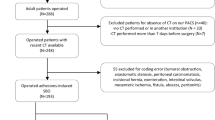Abstract
Most of the small bowel obstruction (SBO) are caused by postoperative adhesions and resolved spontaneously. Findings of intra-abdominal fluid on abdominal computerized tomography (CT) may predict failure of non-operative management (NOM). In this study, we aim to evaluate the correlation between the amount of intra-abdominal fluid and NOM failure. Data of all the patients admitted with adhesional SBO between years 2015 and 2019 were retrospectively collected. Only those who underwent CT as part of the management were included in the study. Patients were divided in 2 groups. Group I included patients that failed NOM, and patients with spontaneous resolution of SBO were included in group II. Both groups were compared. Overall, 197 patients met the inclusion criteria. Group I included 78 patients. The rest of the patients were included in group II. No differences were observed in demographics, number of previous abdominal operations, laboratory tests, CT findings of increased bowel diameter, and presence of fecal sign. In multivariate analysis, only a large amount of intra-abdominal fluid remained significant. NOM failure is more prevalent in patients with adhesional SBO with large amounts of intra-abdominal fluid on CT.
Similar content being viewed by others
References
Long B, Robertson J, Koyfman A (2019) Emergency medicine evaluation and management of small bowel obstruction: evidence-based recommendations. J Emerg Med 56(2):166–176
ten Broek RPG, Krielen P, Saverio SD et al (2018) Bologna guidelines for diagnosis and management of adhesive small bowel obstruction (ASBO): 2017 update of the evidence-based guidelines from the world society of emergency surgery ASBO working group. World J Emerg Surg 13(1):24
Tong JWV, Lingam P, Shelat VG (2020) Adhesive small bowel obstruction-an update. Acute Med Surg 7(1):e587
Kulvatunyou N, Pandit V, Moutamn S et al (2015) A multi-institution prospective observational study of small bowel obstruction: clinical and computerized tomography predictors of which patients may require early surgery. J Trauma Acute Care Surg 79(3):393–398
Zielinski MD, Eiken PW, Bannon MP et al (2010) Small bowel Obstruction—who needs an operation? A multivariate prediction model. World J Surg 34(5):910–919
Kim J, Lee Y, Yoon J-H et al (2020) Non-strangulated adhesive small bowel obstruction: CT findings predicting outcome of conservative treatment. Eur Radiol 31(3):1597–1607. https://doi.org/10.1007/s00330-020-07406-3
Bueno-Lledó J, Barber S, Vaqué J, Frasson M, Garcia-Granero E, Juan-Burgueño M (2016) Adhesive small bowel obstruction: predictive factors of lack of response in conservative management with gastrografin. Dig Surg 33:26–32
Lou Z, Yan F-h, Shi-jie Hu, Meng R-G, Zhang W, En-da Yu, Chuan-gang Fu (2015) Predictive factors for surgical intervention in patients over the age of 80 with adhensive small-bowel obstruction. Indian J Surg 77(Suppl 3):1280–1284
Peacock JL, Kerry SM, Balise RR (2017) Presenting medical statistics from proposal to publication. 2nd ed. New York: Oxford University Press. Chapter 10, Multifactorial analyses; p.134–160
Cirocchi R, Abraha I, Farinella E, Montedori A, Sciannameo F (2010) Laparoscopic versus open surgery in small bowel obstruction. Cochrane Database Syst Rev 2010(2)
Lo OS, Law WL, Choi HK, Lee YM, Ho JW, Seto CL (2007) Early outcomes of surgery for small bowel obstruction: analysis of risk factors. Langenbecks Arch Surg 392:173–178
Hajibandeh S, Hajibandeh S, Panda N (2017) Operative versus non-operative management of adhesive small bowel obstruction: a systematic review and meta-analysis. Int J Surg 45:58–66
Ray NF, Denton WG, Thamer M, Henderson SC, Perry S (1998) Abdominal adhesiolysis: inpatient care and expenditures in the United States in 1994. J Am Coll Surg 186(1):1–9
Iacobellis F, Berritto D, Belfiore MP (2014) Meaning of free intraperitoneal fluid in small-bowel obstruction: preliminary results using high-frequency microsonography in a rat model. J Ultrasound Med 33:887–893
Pinar I, Abdul-Wahid W, Fransgaard T et al (2019) Association between abdominal free fluid and postoperative complications and mortality in patients with small-bowel obstruction. Scand J Surg 108(1):36–41
O’Daly BJ, Ridgway PF, Keenan N, Sweeney KJ, Brophy DP, Hill ADK, Evoy D, O’Higgins NJ, McDermott EWM (2009) Detected peritoneal fluid in small bowel obstruction is associated with the need for surgical intervention. Can J Surg 52(3):201–206
Edwards MK, Kuppler CS, Croft CA, Eason-Bates HM (2018) Adhesive closed-loop small bowel obstruction. Clin Pract Cases Emerg Med 2(1):31–34
Author information
Authors and Affiliations
Contributions
Conceptualization: I. Jeroukhimov, Y. Hershkovitz.
Methodology: I. Jeroukhimov, Y. Hershkovitz, Y. Nir.
Formal analysis and investigation: I. Ashkenazi, Dykman D.
Writing–original draft preparation: Y. Hershkovitz, Y. Nir.
Writing–review and editing, final approval of manuscript: I. Jeroukhimov, Y. Nir, I. Ashkenazi, Y. Hershkovitz, Dykman D.
The authors declare no competing interests.
Corresponding author
Ethics declarations
Ethics Approval
This study was approved by the institution’s research ethics committee (protocol 322–19).
Additional information
Publisher's Note
Springer Nature remains neutral with regard to jurisdictional claims in published maps and institutional affiliations.
Rights and permissions
About this article
Cite this article
Nir, Y., Hershkovitz, Y., Askenazi, I. et al. Does Amount of Intra-abdominal Fluid on CT May Predict Failure of Non-operative Management in Patients with Small Bowel Obstruction?. Indian J Surg 84, 715–719 (2022). https://doi.org/10.1007/s12262-021-03052-1
Received:
Accepted:
Published:
Issue Date:
DOI: https://doi.org/10.1007/s12262-021-03052-1




